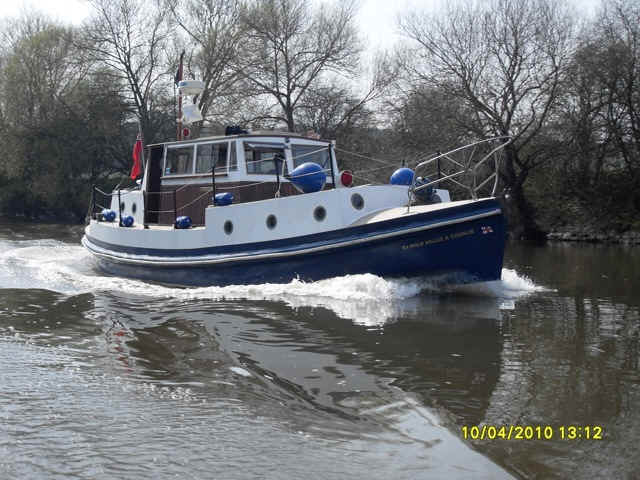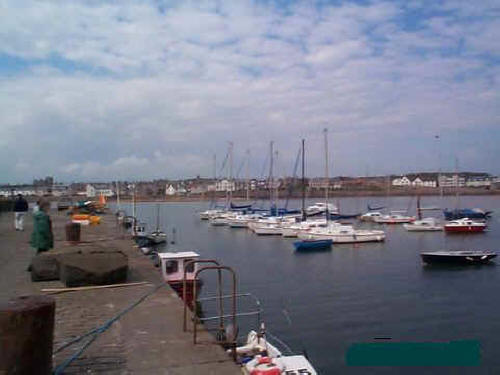|
Boat Talk
For
those
who go down to the sea in ships.
One of
the main subjects of conversation of boys and men who live near
the sea is boats. I’m sure every one of us has gone through a time of wanting to run away to sea, to sail the world, to find a
deserted Treasure Island in the far away Caribbean, to live the life of
Robinson Crusoe or Captain
Blood. The closest I came to this dream was when the
Anstruther lifeboat, the Nellie and
Charlie, was put up for sale. After seventeen years of being in
service the Nellie and Charlie was replaced by a next generation lifeboat,
The James and Ruby Jackson.
The Nellie and Charlie was offered for sale either with or without
it’s large engine. Without the engine
the price was 300 pounds, a fraction of what it must have cost
when it was built. A placard with the facts was attached to the
lifeboat and there it lay for months, moored to the
harbor wall, just across
the road from where the famous Anstruther
Fish and Chip shop is now. Being able to buy the lifeboat
without it’s big engine was a plus.
All lifeboats are pampered from day one and the Nellie and
Charlie was no exception. When it was put up for sale it looked like it had just
arrived brand new from the builder. The hull was carvel built
with double diagonally fastened mahogany planking and with a layer
of white leaded calico between the layers of the planking. It
was a vessel that I knew could safely go anywhere in the world once it
was decked over and rigged to become a motor/sailer with a low profile lug
sail and a small engine. There were three of us in on this
reverie. With me were my Earlsferry pal, Jimmy Linton, "Jems"
and an
Elie pal Tommy Grant. (Tommy Grant's father was Sir Michael Nairne's butler at Elie House.
Sir
Michael was the inventor of linoleum floor coverings.) We
reasoned that it would take all three of us to buy, refit and
run the boat. At the time the
boat was for sale a Glasgow instrument shop by the name of
Charles Frank was advertising government surplus brand new ex
navy sextants and I got on a bus to Glasgow and bought one along
with instructions as to the navigation of ocean going vessels. I also
had an Anstruther man by the name of Tom Tothill teach me
the rudiments of ocean navigation. Tom was a navigator who had
crossed the Atlantic several times in sail boats. But that daydream wasn’t to be as
while we were doing just that somebody came along and bought the
Nellie and Charlie. "What's fur ye'll no gan
bye ye". The dream was fun while it lasted.
The
2nd of June 2010.
Incredible.
Out of the blue. Today I received an email from Bevis Musk in which he tells me
that he is the proud owner of the Nellie and Charlie and that
after 77 years the Nellie and Charlie is used every week and is
still in excellent condition. What a testimony to her builders and
those who have taken care of her for all of those years. For
anyone who would like to see her Bevis keeps the
"Nellie" moored at Sharpness on the Gloucester and
Sharpness Canal about 50 metres from the estuary of the River
Severn in England. Next year, 2011, Bevis is planning to take the
'Nellie" back to Anstruther for a visit where she will be on display at
the Anstruther Lifeboat Day Festival.
I wonder whether
Bevis and the Nellie will
go by way of the Irish Sea, the Forth and Clyde Canal, the
Falkirk Wheel and the Firth of Forth or whether they will go by
way of the longer route
that will take them further north to the Caledonian Canal to
cross Scotland from west to east by way of Loch
Ness, where the monster lives, then come back down the east
coast to Anstruther in the Firth of Forth? No matter which way
they go it will be a memorable cruise. Which way they go
and return will, no doubt, be a last minute decision and one
determined by time available and the prevailing weather.
When
the Nellie cruises in to Anstruther Harbour and ties up at the
pier, next to "The Reaper" what a homecoming that will be.

The "Nellie and
Charlie" as she is today.
There's no mistaking her
ancestry.
The
"Nellie and Charlie" is now listed on the register of
National Historic Ships. www.nationalhistoricships.org.uk
At the
end of World War II a considerable number of government surplus
boats came on the market at a boat yard at
Dundee and four of them
were bought by Elie/Earlsferry
people and were brought to the Elie
harbor. Two of them were 30 plus feet or so long displacement hull cabin
cruisers and the other two were 20 foot
planing hull runabouts. The first of the cabin cruisers
was an all white boat and was bought by Johnny Green, an Elie
man who named his boat the HeatherIan. The second cruiser was all varnished mahogany
and was in like new condition and was bought by his brother
David who named it the Heather. The Heather was the best looking boat in the Elie
harbor. I cruised the Dundee boat yard, made an offer and bought
one of the 20 foot runabouts that were for sale. I was told
that it had been the captain’s going ashore jolly-boat on the ship
that it had come off. There it sat all spic and span in the yard on an ex navy
trailer that had been used for hauling torpedoes and just
waiting for someone to tow it away, which I did. I named it the
Comet which turned out to be a misnomer. The Comet instead of
being a fast boat was an absolute dog. It was a beautiful
looking boat but it’s beauty was skin deep. The problem was that it had been built of the very
best and overly thick mahogany throughout and was way too heavy
for it’s four cylinder American
Willys jeep engine. Coupled to the engine was a heavy Kermath
epicyclic
gear box. The engine was
fresh water cooled and had a secondary, indirect, salt water heat
exchanging cooling system. All of this plumbing was made of very heavy
copper and brass that added to the boat's dead weight. The boat
was designed to be a planing vessel
but at full throttle only once or twice did I get it to come up
on the step and plane. Anything less than maximum throttle and
it sank down into the water to function as a slow displacement
hull boat, like a draft horse hauling a plough, which it wasn’t meant to be. The boat was a
disappointment after all the work I'd put into it to spruce it up and it wasn’t long before I sold it at a giveaway
price. But the Comet did provide me with one lasting good
memory. While I was going all over the boat and getting it ready
for it’s first jaunt I determined
that the engine needed new spark plugs, distributor
rotor, points and condenser. I soon discovered that it being an
American product nobody in the UK had these spare parts. Luckily
the Willys address was on the engine’s name tag so I wrote to
Willys in the US to explain my dilemma and asked for the parts and to first let me
know how much I would owe as I thought they would want to be
paid before they shipped the parts. No letter came but about two
months later a box was delivered to me. In the box,
instead of the bits and pieces for the distributor that I’d
asked for, were two brand new complete distributors, six sets of
spark plugs and several other miscellaneous engine spare parts.
Along with the parts was a letter from Willys saying that they
had a good supply of the parts and there was no charge for the
shipment and if I needed any more parts at any time to just let
them know and they’d send them no charge. Wow. This must have
been pay-back carry over wartime camaraderie. Whatever it was I thanked
them very much for their generosity.
By
contrast the next runabout that showed up in the harbor was the
same size of runabout as the Comet but in comparison it was a shabby,
scungie looking
boat that badly needed a shave and a haircut and a new paint job. It was
clinker fastened, was
lightly built and had a large direct drive V-8 engine.
This boat was named the Vosper.
But despite its looks, wow, could the Vosper ever fly.
The Vosper had the right power to weight ratio. Once I was invited
to go along with its owner to try it out. At a little
over half throttle that boat lifted up on the step and planed as
easy as could be, like a seabird taking flight. It must have been doing at least
an easy 30 miles an hour. What a contrast to
my beautiful, at anchor, Comet.
Just
shows you; as you can't judge a book by its cover, neither can
you judge a boat by it’s
color.

Elie
Harbour
Today,
The Granary at the Elie harbour has been converted into
modern residential flats but in my young day The Granary was
used as a place of commerce. Small puffer coaster vessels came
to unload coal from the Wellesley coal pit at Methil.
Coal was the prime means of providing fuel for the village at that
time. Coal was also baked in a battery of retorts that
converted coal into coal gas and coke at Jimmy Stevens gas works at Liberty.
Bags of grain and potatoes from
the local farms were stored at The Granary where at a
later time they were slid down
a chute and loaded into the holds of coaster vessels to be shipped elsewhere.
In
the wintertime the lower level of the granary was used
to store small boats and the nets and fishing gear of
the locals and the gear that belonged to the commercial salmon
fishermen. A
summertime use of the Granary was as a place for boys who were trainees on
the Mars Training Ship at Dundee, to stay at when they came
to Elie for a summer break. Mars ship boys wore
cadet naval uniforms and part of their training was
to play musical instruments. When they came to Elie
their marching band entertained the locals as
they paraded through the village. And
lastly if you want to advance in the
Navy. |